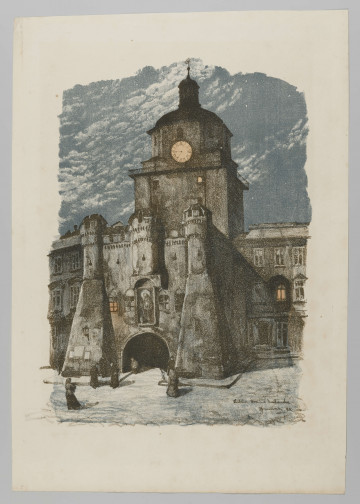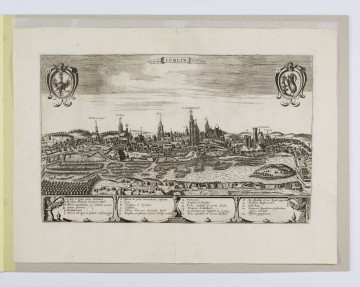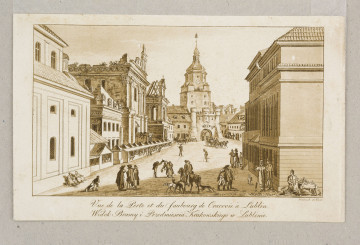
Lublin. Kraków Gate
1918
National Museum in Lublin
Part of the collection: Photographic iconography of Lublin from 1890–1939
The Krakowska Gate is one of the former city gates within the walls of medieval Lublin. For centuries it was a defensive building. It got its name from the route leading towards Kraków. Its construction began in the mid-14th century, during the reign of Casimir the Great. In later centuries it was raised and strengthened with a fore gate protruding towards today's Łokietek Square. After the renovation in 1782, the royal monogram of Stanisław August Poniatowski (SAR - Stanislaus Augustus Rex) was placed on its top. In the following century paintings appeared on it - of Our Lady from Krakowskie Przedmieście Street and St Anthony of Padua from the side of the Old Town.
The gate was built on a plan close to a square. A tower was erected above the passage, reaching about 40 m above street level. An octagonal tier topped with a sheet metal helmet was set over the rectangular body. The lower entrance gate was reinforced on both sides with buttresses made of light stone. It used to be (presumably in the form of a barbican) protruded more in the direction of the suburb called Krakowskie Przedmieście.
The builders took care of the decorative appearance. The oldest part of the gate was made of bricks and limestone, arranged in a red-and-white chequered pattern. The tower was decorated with dark cherry-coloured bricks incorporated into bricks of a lighter colour. A plastered tier with two clock faces was placed higher. Below them are now small balconies. There used to be an iron gallery for the fire brigade at this height, erected in 1845. It can be seen on Alexander Stepanoff's late 19th-century photograph.
For years, the Central Hotel of the Steinert (Sztajnert) family was located in the vicinity of the Krakowska Gate. On its top information about the current temperature was posted. Bugles were played from it. In 1917, the square in front of the gate was named the King Władysław Łokietek Square. It was one of the busiest places in the city, where carriages stopped and street merchants gathered. After World War II, the historic building was restored and designated as the seat of the Lublin City History Museum. Its Gothic appearance was restored, with the plasterwork removed. The Renaissance bronze bell hanging at the top, damaged in July 1944, was brought inside the tower for an exhibition on the history of the city.
Author / creator
Dimensions
cały obiekt: height: 14,8 cm, width: 19 cm
Object type
photography
Technique
manual script
Material
paper, cardboard, ink, pencil
Creation time / dating
Creation / finding place
Owner
The National Museum in Lublin
Identification number
Location / status

1918
National Museum in Lublin

1729
National Museum in Lublin

1821
National Museum in Lublin
DISCOVER this TOPIC
Museum of King Jan III's Palace at Wilanów
DISCOVER this PATH
Educational path